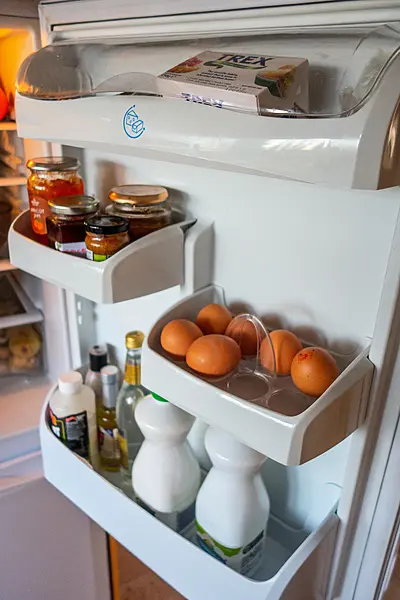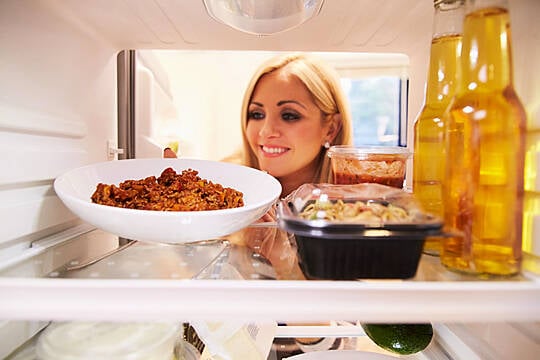They’re not especially glamorous, but there aren’t many items of furniture you interact with more than your fridge. Three times a day at least (plus, let’s be honest, snacks), fridges are essential ever-presents in our day-to-days, and a little TLC would be well-earned.
Here’s how to clean, organise and rationalise your fridge…
To refrigerate, or not to refrigerate
The fridge just feels like an appropriate place for food, but there are plenty of edibles that actively suffer from refrigeration.
Storing uncut avocados in the fridge sometimes makes them harden rather than ripen, while melons are similarly happy in the fruit bowl until they’ve been opened up.

The moisture in the fridge can make some vegetables go soft and watery – onions, cucumbers and some berries, to name a few – though they will need a cool and dry alternative.
You do not need to store pickles in the fridge, as they are already fully preserved. Some food will virtually never go off wherever you keep it, like honey (honey found in the Great Pyramid in Egypt was technically still edible), while foods like coffee and chocolate will do fine in the fridge but will lose flavour. Nuts too will last longer in the fridge once opened, but will lose a bit of bite.
Eggs are perhaps the classic everyone-refrigerates-them-but-you-don’t-need-to item, and if your kitchen is comfortably below 20 degrees, they’ll do fine in the cupboard for a while. Refrigerated eggs do last longer, but a pack at the back of the fridge is more likely to be forgotten and go rotten, and with eggs – of all things – you don’t want that.
Organising your fridge
If you’ve ever found a jar at the back of your fridge that’s years past its sell by date, and had to dispose of it wearing rubber washing up gloves, then fridge organisation is for you.
Some of it’s just common sense. The things you need most and those that will go off quickly need to be visible and reachable, so it’s sensible to have some sort of system.
The door is not as cold as the rest of the fridge, thanks to its frequent forays out into the middle of the room, so longer-life items are well-served there, as are products you’ll likely get through very fast.
Inside the fridge the top shelf is the least cool, so if it isn’t above your eyeline (which might make it easy-to forget) it’s the perfect to store short-term visitors like leftovers.
Meat and fish is best kept at the bottom of the fridge – it’s comparatively cold, and there’s less chance they might drip onto other food. That leaves your middle shelves for longer-term foodstuffs like unopened butter and cheese.
Cleaning the fridge
It stores our food, so of course we want our fridge to be clean, but since fridges are literally always in use a little planning helps. You might want to clean it just before going away, or on some other occasion when you’re deliberately running down supplies.
You’ll have to take whatever’s left out into the warm so try to-consume any meat or fish, and put spoilage-prone foods in a sealed bag in a cool, dry place. When your fridge is empty, start by washing any removable parts like drawers and shelves, which you can do in the sink using normal washing techniques.
For the fridge interior, some people prefer not to use strong chemicals around things we’re going to eat, but that doesn’t mean you can’t get your fridge spotless. Sterilising fluid is a good – often sold for cleaning babies’ bottles – which combines with cold water for a reliable bacteria busting solution.
It’s best not to use very hot water for the interior, as that will raise your fridge’s temperature enough to significantly delay when it can again cool your food.

Even food-friendlier – since it is, itself, a food – is distilled white vinegar, which can be bought cheaply in the supermarket in large bottles. Mixed 50-50 with water and perhaps put into a spray bottle, it’s a safe and simple cleaner, while the vinegary tang doesn’t hang around for long. If you’ve got a few stubborn stains, add a bit of bicarb to the mix for an equally edible boost.
If there’s a lot of grime in the folds of the door seal or the shelf channels, a cotton bud might be a useful tool, or just the corner of a cloth. Once your fridge is clean, dry with a paper towel or cloth, and let it cool awhile before returning your rations to their allotted spots.







